| Revision as of 16:23, 29 January 2013 editClueBot NG (talk | contribs)Bots, Pending changes reviewers, Rollbackers6,439,241 editsm Reverting possible vandalism by 85.166.50.68 to version by Andrewa. False positive? Report it. Thanks, ClueBot NG. (1473169) (Bot)← Previous edit | Revision as of 13:58, 1 February 2013 edit undo87.41.52.6 (talk)No edit summaryNext edit → | ||
| Line 3: | Line 3: | ||
| {{Drum kit components}} | {{Drum kit components}} | ||
| A '''drum kit''', '''drum set'''<ref>Peckman |
A '''drum kit''', '''drum set'''<ref>Peckman gavin and adam (2007). ''Picture Yourself Drumming'', p.30. ISBN 1-59863-330-9.</ref> or '''trap set''' is a collection of ]s and other ]s set up to be played by a single player.<ref> http://www.music.vt.edu/musicdictionary/textd/drumkit.html retrieved 29 January 2012 </ref> | ||
| Percussion instruments can be divided into three main categories: ]s which when played give out their own natural sound, ]s, which depend for their sound on a membrane stretched over a resonator, and ]s, involving struck strings. The traditional drum kit is a collection including both idiophones and membranophones.<ref>Remnant, M. (1989). Musical instruments. (pp. 159-174). London: B.T. Batsford Ltd.</ref> More recently it has also included ]s, with both hybrid and entirely electronic kits now in common use. | Percussion instruments can be divided into three main categories: ]s which when played give out their own natural sound, ]s, which depend for their sound on a membrane stretched over a resonator, and ]s, involving struck strings. The traditional drum kit is a collection including both idiophones and membranophones.<ref>Remnant, M. (1989). Musical instruments. (pp. 159-174). London: B.T. Batsford Ltd.</ref> More recently it has also included ]s, with both hybrid and entirely electronic kits now in common use. | ||
Revision as of 13:58, 1 February 2013
| This article needs additional citations for verification. Please help improve this article by adding citations to reliable sources. Unsourced material may be challenged and removed. Find sources: "Drum kit" – news · newspapers · books · scholar · JSTOR (March 2011) (Learn how and when to remove this message) |
| The drum kit |
|---|
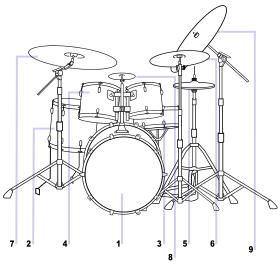 |
| Not shown |
| See also |
A drum kit, drum set or trap set is a collection of drums and other percussion instruments set up to be played by a single player.
Percussion instruments can be divided into three main categories: idiophones which when played give out their own natural sound, membranophones, which depend for their sound on a membrane stretched over a resonator, and chordophones, involving struck strings. The traditional drum kit is a collection including both idiophones and membranophones. More recently it has also included electronic instruments, with both hybrid and entirely electronic kits now in common use.
More specifically, a standard modern kit (for a right-handed player), as used in popular music, taught in many music schools, and for which qualifications are available from Trinity College London and similar institutions consists of:
- A snare drum, mounted on a specialised stand, placed between the player's knees and played with drum sticks (which may include rutes or brushes).
- A bass drum, played by a pedal operated by the right foot.
- A hi-hat stand and cymbals, operated by the left foot and played with the sticks, particularly but not only the right hand stick.
- One or more tom-tom drums, played with the sticks.
- One or more cymbals, played with the sticks, particularly but not only the right hand stick.
A drum kit is usually played seated on a drum stool or throne.
Most drummers extend their kits from this basic pattern, adding more drums, more cymbals, and many other instruments. In some styles of music particular extensions are normal, for example double bass drums in heavy metal music. On the other extreme but more rarely, some performers omit elements from even the basic setup, also dependent on the style of music and individual preferences.

History

Beginnings
The first recognizable ancestors of the modern drum kit were born in the Vaudeville era. Pecuniary and theater space considerations demanded that fewer percussionists covered more percussion parts. In military and orchestral music settings, drums and cymbals were traditionally played separately by one or many percussionists. The bass drum, snare drum, cymbals and other percussion instruments were all played using hand-held drum sticks. Circa 1890, experimentation with foot pedals began. Many patented their systems such as Dee Dee Chandler of New Orleans 1904-05. Liberating the hands for the first time, this evolution saw the bass drum played with the foot of a standing percussionist (thus the term "kick drum") and became the central piece around which every other percussion instruments would later revolve. Ludwig-Musser, William F. Ludwig Senior and his brother Theodor Ludwig founded the Ludwig & Ludwig Co. in 1909 and patented the first workable bass drum pedal system, paving the way for what was to become the modern drum kit.
Development



By World War I drum kits were characterized by very large bold marching bass drums and many percussion items suspended on and around them, and they became a central part of jazz music, specifically (but not limited to) dixieland. Metal consoles were developed to hold Chinese tom-toms, with swing out stands for snare drums and cymbals. On top of the console was a "contraption" tray (shortened to "trap") used to hold items like whistles, klaxons and cowbells, thus drum kits were dubbed "trap kits." Hi-hat stands appeared around 1926.
By the 1930s, Ben Duncan and others popularized streamlined trap kits leading to a basic four piece drum set standard: bass, snare, tom-tom, and floor tom. In time legs were fitted to larger floor toms, and "consolettes" were devised to hold smaller tom-toms on the bass drum. In the 1940s, Louie Bellson pioneered use of two bass drums, or the double bass drum kit. Gene Krupa was the first drummer to head his own orchestra and thrust the drums into the spotlight with his drum solos. Others would soon follow his lead. Krupa is also known to be the first to record a drum solo on a commercial record.
In this era, jazz drummers were highly influential in developing both the concept of the modern drum kit and extending the playing techniques. Important drummers of the jazz tradition included Gene Krupa, "Papa" Jo Jones, Art Blakey, Max Roach, Elvin Jones, Philly Joe Jones, Roy Haynes, Buddy Rich, Louis Bellson, Tony Williams, Jack DeJohnette, Joe Morello and many more.
Rock and Roll

With the ascendance of rock and roll, a watershed moment occurred between 1962 and 1964 when the Surfaris released "Wipe Out," and when Ringo Starr of The Beatles played his Ludwig kit on American television; events that motivated legions to take up the drums.
A trend towards bigger drum kits in Rock music began in the 1960s and gained momentum in the 1970s. By the 1980s, widely popular drummers like Billy Cobham, Carl Palmer, Nicko McBrain, Phil Collins, Stewart Copeland and perhaps most notably Neil Peart were using large numbers of drums and cymbals and had also begun using electronic drums. In the 1990s and 2000s, many drummers in popular music and indie music have reverted back to basic four piece drum set standard.
In the 21st century, it is not uncommon for drummers to use a variety of auxiliary percussion instruments, found objects, and electronics as part of their "drum" kits. Popular electronics include: electronic sound modules; laptop computers used to activate loops, sequences and samples; metronomes and tempo meters; recording devices; and personal sound reinforcement equipment (e.g., a small PA system to amplify electronic drums and provide a monitor for singing).
Recording
On early recording mediums (until 1925) such as wax cylinders and discs carved with an engraving needle, sound balancing meant that musicians had to be literally moved in the room. Drums were often put far from the horn (part of the mechanical transducer) to reduce sound distortion. Since this affected the rendition of cymbals at playback, sound engineers of the time remedied the situation by asking drummers to play the content of the cymbals onto woodblocks, temple blocks and cowbells for their loudness and short decay.
This recording-specific particularity had the effect of altering the evolution of the drum set and of stigmatizing the sound of the music recorded at the time. The drum kit featured in many of rock and roll songs and the Rock and Roll period played a big role in modernizing the drum kit.
Components
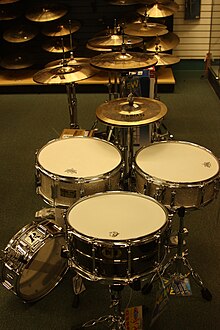
Drums
Drum sizes
See Common configurations below for typical drum sizes.
Traditionally, drum sizes were expressed as depth x diameter, both in inches. More recently, many drum kit manufacturers have begun instead to express the size as diameter x depth, again in inches.
Manufacturers still using the traditional format in their catalogues include:
while those using diameter x depth include:
- Brady Drum Company
- Mapex Drums
- Meinl Percussion
- Pearl Drums
- Premier Percussion
- Rogers Drums
- Sonor
- Yamaha Drums
For example, a hanging tom 12" in diameter and 8" deep would be described by Tama as 8x12, but by Pearl as 12x8, and a standard diameter Ludwig snare drum 5" deep is a 5x14, while a Premier of the same dimensions is a 14x5.
Snare drum

The snare drum is the centre of the kit. It provides the strongest regular accents, played by the left hand, and the backbone for many fills.
Toms
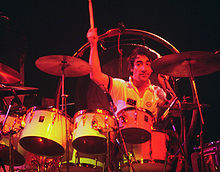
Tom-tom drums or toms for short are drums without snares and played with sticks, and are the most numerous drums in almost all kits. They provide the bulk of most drum fills and solos.
They include:
- Traditional double-headed rack toms, of varying depths.
- Floor toms.
- Single-headed concert toms.
- Rototoms.
The smallest and largest drums without snares, such as octobans and gong drums, are sometimes considered toms and sometimes not, and if not there are many borderline cases.
The naming of common configurations is largely a reflection of the number of toms, as only the drums are conventionally counted, and these configurations all contain one snare and one or more rarely two bass drums, the balance being toms.
Bass drum
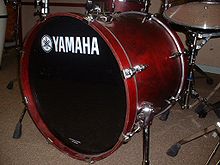
The bass drum gives a regular but often varied foundation to the rhythm. Beginners tend to play simple bass drum patterns, moderate players complex ones with many strokes, and accomplished players more subtle ones with fewer strokes.
Other drums
Octobans were designed for use in a drum kit, extending the tom range upwards in pitch.

Timbales are tuned much higher than a tom of the same diameter, and normally played with very light sticks. They have relatively thin, fragile heads and a very different tone to a tom, but are used by some drummers to extend the tom range upwards. Alternatively, they can be fitted with tom heads and tuned as shallow concert toms. Attack Timbales and mini timbales are reduced diameter timbales designed specifically for drum kit usage, the smaller diameter allowing for thicker heads for the same pitch and head tension.
Similarly, most hand drums cannot be played with drum sticks without risking damage to the head and to the bearing edge, which is not protected by a drum rim. For use in a drum kit they may be fitted with a suitable drum head and played with care, or played by hand.
Cymbals

Cymbals are as important in most drum kits as the drums themselves. The oldest idiophones in music are cymbals, traditionally associated with Turkey where Zildjian has predominantly made them since 1623.
Beginners cymbal packs normally contain four cymbals: one ride, one crash, and a pair of hi-hats. A few contain only three cymbals, using a crash/ride instead of the separate ride and crash. The sizes closely follow those given in Common configurations below.
Most drummers soon extend this by adding another crash, a splash or a china, or even all three.
Ride cymbal
Main article: ride cymbalThe ride cymbal is most often used to keep a constant rhythm, every beat or more often. Development of this ride technique is generally credited to Baby Dodds.
Most drummers have a single main ride, near their right hand, most often 20" but 16"-24" are not uncommon. It is most often a heavy, standard cymbal, but some drummers use a swish cymbal, sizzle cymbal or other exotic as the main or only ride, particularly for jazz. In the 1960s Ringo Starr used a sizzle cymbal as a second ride particularly for use during guitar solos.
Hi-hats
Main article: hi-hatThe hi-hat has a similar function to the ride cymbal; The two are rarely played at once, but one or the other keeps the fine rhythm much of the time, played by the right stick of a right-handed drummer. Changing between ride and hi-hat, or between either and a leaner sound with neither, is often used to mark a change from one passage to another, for example to distinguish verse and chorus.
Crashes
Main article: crash cymbalThe crash cymbals are the strongest accents, marking crescendos and climaxes, vocal entries, and major changes of mood. A cymbal crash is often accompanied by a strong kick on the bass drum pedal, both for musical effect and to support the stroke.
In the very smallest kits, in jazz, and at very high volumes, ride cymbals may be used as crashes. Some hi-hats will also give a useful crash, particularly thinner hats or those with an unusually severe taper. At low volumes, producing a good crash from a cymbal not particularly suited to it is a highly skilled art. Alternatively, specialised crash/ride and ride/crash cymbals are specifically designed to combine both functions.
Other cymbals
Main article: effects cymbalCymbals other than rides, hi-hats and crashes are called effects cymbals when used in a drum kit.
Most extended kits include one or more splash cymbals and at least one china cymbal. Major cymbal makers produce cymbal extension packs consisting of one splash and one china, or more rarely a second crash, a splash and a china, to match some of their starter packs of ride, crash and hi-hats.
Other acoustic instruments

Other instruments that have regularly been incorporated into drum kits include:
- Wood block and cowbell. These are traditional in some forms of music.
- Tambourine, particularly mounted on the hi-hat stand above the cymbals. An ordinary tambourine can be used, or a tambourine produced specially for drum kit use.
- Timbales can be used to extend the ring of tom-toms, particularly when the drummer owns them for other reasons. A traditional timbale is tuned far higher than a tom of the same diameter, so the result is not ideal. Some makers produce smaller timbales 8" or 10" in diameter more suited to drum kit usage, see Timbales#Non-traditional use.
- Xylophone or glockenspiel.
- Tubular bells.
- Gongs.
- Bar chimes.
- Triangles.
- Found objects, including spanners, brake drums, buckets, cardboard boxes, and jam and kerosene tins.
See also Extended kits below.
Electronic drums

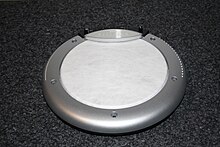

As well as providing an alternative to a conventional drum kit, electronic drums can be incorporated into a kit.
This is possible in two ways:
- Triggers are sensors that can be attached to drum kit components. In this way, an electronic drum sound will be produced when the instrument is played, as well as the sound made by the instrument.
- Trigger pads can be mounted alongside other components. These pads make no significant sound themselves, but purely trigger the electronic sound, and are played with the same drum sticks as other drum kit components.
In either case, a control unit (brain) with suitable sampled sounds, and amplification equipment are both required. Sometimes, for the sake of appearance or of the desired "feel" of the instrument, a drum with a trigger will be used as a trigger pad by muffling it so heavily that no significant sound at all is produced, see Electronic drum#Acoustic triggered drum kit.
A trigger pad can contain up to four independent sensors, each of them capable of sending to the brain information describing the timing and intensity of a stroke. A circular drum pad will normally contain only one sensor, but a cymbal-shaped pad often contains two, one for the body and one for the rim of the cymbal, and a triangular pad may contain four, one for the body, played by the stick tips, and one for the rim of each side, played by the stick shafts. (Commonly called a rim shot and often used to trigger a similar effect, playing the rim of the trigger pad is a significantly different and far simpler technique, as it is not necessary or even desired to strike the body of the pad.)
Trigger sensors are most commonly used to replace the acoustic drum sounds. For example, in a live performance in a difficult acoustical space, a sensor may be placed on every drum and cymbal, and used in each case to trigger a similar sound. These sounds are then amplified through the PA and are all the audience hears, and can be amplified to any level without the feedback problems associated with microphones. The sound of the drums and cymbals themselves is heard by the drummer and possibly other musicians, but even there the foldback system will be fed from the electronic sounds rather than the live sounds. The drums can be heavily muffled, and their tuning and even quality is less critical. In this way much of the atmosphere of the live performance is retained but without some of the problems associated with amplified drums.
Trigger sensors can also be used in conjunction with conventional or built-in microphones. If some components of a kit prove more difficult to "mike" than others, sensors may be used on only the more difficult instruments.
Trigger pads on the other hand when used in a conventional kit are most commonly used to produce sounds not otherwise available. Any sound that can be sampled can be used. Recordings of barking dogs and stereo recordings of aircraft taking off and landing have for example been used to great effect, as well as the more obvious electronically generated sounds.
Hardware
Main article: drum hardwareHardware is the name given to the stands that support the instruments. Generally the term also includes the hi-hat pedal and bass drum pedal or pedals, and the drum stool, but not the drum sticks.
Hardware is carried along with sticks and other accessories in the traps case, and includes:
- Cymbal stands.
- Hi-hat stand.
- Floor tom feet.
- Hanging tom brackets or arms.
- Snare drum stand.
- Bass drum pedal or pedals.
- Drum key.
Particularly for large kits, many or even all of the stands may be replaced by a drum rack.
Common configurations

Drum kits are traditionally categorised by the number of drums, ignoring cymbals and other instruments. Snare, tom-tom and bass drums are always counted; Other drums such as octobans may or may not be counted.
The sizes of drums and cymbals given below are typical. Many drummers differ slightly or radically from them. Where no size is given, it is because there is too much variety to call a typical size.
Three-piece

A basic, conventional three-piece kit consists of bass drum, 14" diameter snare drum, 12"-14" hi-hats, and a single 12" diameter hanging tom 8"-9" in depth and a suspended cymbal in the range 14"-18", both mounted on the bass drum.
Such kits were common in the 1950s and 1960s and may still be found in small acoustic dance bands. It is a common configuration for kits sold through mail order, and, with smaller size drums and cymbals, for very young drummers.
Four-piece

A four-piece kit extends the three-piece by one tom, either a second hanging tom mounted on the bass drum and often displacing the cymbal, or a floor tom. Normally another cymbal is added as well, so there are separate ride and crash cymbals, either on two stands, or the ride on the bass drum to the player's right and the crash on a stand.
The standard cymbal sizes are 16" crash and 18"-20" ride, with the 20" ride most common.
Four piece with floor tom
The floor tom is most often 14" for jazz, and 16" otherwise.
Many historic bands and early rock music recordings used this configuration, notable users including Ringo Starr in the Beatles, Mitch Mitchell in the Jimi Hendrix Experience, John Barbata in the Turtles and many others.
The four-piece kit with floor tom remains popular, particularly for jazz.
Four piece with two hanging toms
If a second hanging tom is used, it is 10" diameter and 8" deep for fusion, or 13" diameter and one inch deeper than the 12" diameter tom otherwise, or very occasionally a 14" diameter hanging tom is added to the 12", both being 8" deep. In any case, both toms are most often mounted on the bass drum with the smaller of the two next to the hi-hats, on the left for a right-handed drummer.
These kits are particularly useful for smaller venues where space is limited.
Five-piece

The five-piece kit is the full entry level kit and the most common configuration. It adds a third tom, making three in all.
A fusion kit will normally add a 14" tom, either a floor tom or a hanging tom on a stand to the right of the bass drum, in either case making the tom lineup 10", 12" and 14".
Other kits will normally have 12" and 13" hanging toms plus either a 14" hanging tom on a stand, a 14" floor tom, or a 16" floor tom. For depths, see Tom-tom drum#Modern tom toms. In recent years, it is very popular to have 10" and 12" hanging toms, with a 16" floor tom. This configuration is often called a hybrid setup.
The bass drum is most commonly 20" in diameter, but rock kits may use 22" or 24", jazz 18", and big bands up to 26".
A second crash cymbal is common, typically an inch or two larger or smaller than the 16", with the larger of the two to the right for a right-handed drummer, but a big band may use crashes up to 27" and ride up to 24" or very occasionally 26". A rock kit may also substitute a larger ride cymbal or larger hi-hats, typically 22" for the ride and 15" for the hats.
Most five-piece kits at more than entry level also have one or more effects cymbals. Adding cymbals beyond the basic ride, hi-hats and one crash configuration requires stands in addition to that of standard drum hardware packs. Because of this, many higher level kits are sold with little or even no hardware, to allow the drummer to choose the stands and also the bass drum pedal they prefer. At the other extreme, many entry level kits are sold complete with two cymbal stands, most often one straight and one boom, and some even with a standard cymbal pack, a stool and a pair of drum sticks.
Small kits

If the toms are omitted completely, or the bass drum replaced by a pedal-operated beater on the bottom skin of a floor tom and the hanging toms omitted, in either case the result is a two-piece kit. Such kits are particularly favoured in musical genres such as trad jazz, rockabilly and swing blues.
Some rockabilly kits and beginners kits for very young players omit the hi-hat stand. In rockabilly, this allows the drummer to play standing rather than seated.
Although these kits may be small with respect to the number of drums used, the drums themselves are most often normal sizes, or even larger in the case of the bass drum. Kits using smaller drums in both smaller and larger configurations are also produced for particular uses, such as boutique kits designed to reduce visual impact or space requirements, travelling kits to reduce luggage volume, and junior kits for very young players. Smaller drums also tend to be quieter, again suiting smaller venues, and many of these kits extend this with easily fitted extra muffling to the point of allowing quiet or even silent practice in a hotel room or bedroom.
Extended kits
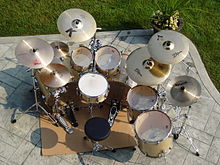
Common extensions beyond these standard configurations include:
- Effects cymbals, particularly splash cymbals and china cymbals.
- Double bass drums. Double bass drums or a double bass pedal are standard for some genres, particularly in heavy rock music.
- Extra hanging toms.
- Extra crash cymbals.
- A crash/ride cymbal in addition to the main ride.
- A second, larger floor tom.
- One or more octobans or a pair of mini timbales.
- A second pair of hi-hats mounted as cable hats or X-hats.
- Cymbal stacks.
- Individual tiger, wind or chau gongs.
- Multiple ride cymbals. A sizzle cymbal thinner and larger than the main ride was once common as a second ride or crash/ride even in a four-piece kit but is now less so. Jazz drummers however may still have two or more ride cymbals even in a small kit.
See also other acoustic instruments above. Another versatile extension becoming increasingly common is the use of some electronic drums in a mainly conventional kit.
Less common extensions found particularly but not only in very large kits include:
- Multiple snare drums.
- Multiple bass drums beyond the double bass drum setup.
- Gong drums (single headed bass drums, played with sticks or mallets).
- Sets of gongs, tuned or untuned.
- Sound effects such as a thunder sheet.
- One or more crotales.
- Instruments "borrowed" from orchestral percussion, such as timpani.
- Instruments "borrowed" from marching band percussion, such as the tuned bass drums used in the drumline.
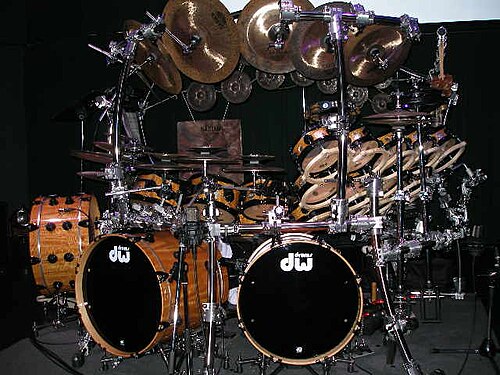
Accessories
Sticks
Main article: drum stickThe most common kit drumming sticks are wooden sticks modelled on, or in some cases identical to, those originally designed for use with the snare drum. These come in a variety of weights, conventionally expressed as a number, and tip designs, expressed as a letter following the number, with the higher numbers indicating lighter sticks. Thus, a 7A is a common jazz stick with a wooden tip, while a 7N is the same weight of stick with a nylon tip, and a 7B is a wooden tip but with a different tip profile, shorter and rounder than a 7A. A 5A is a common wood tipped rock stick, heavier than a 7A but with a similar profile. The numbers are most commonly odd but even numbers are used occasionally, in the range 2 (heaviest) to 9 (lightest).
The exact meanings of both numbers and letters differ from manufacturer to manufacturer, and some sticks are not described using this system at all, just being known as Jazz (typically a 7N or 8N) or Heavy Rock (typically a 4B or 5B) for example. The most general purpose stick is a 5A (wood tip, for snare tone) or 5N (nylon tip, for cymbal tone).
Other sticks commonly used are rutes, consisting of a bundle of canes, and wire or nylon drum brushes. More rarely, other beaters such as cartwheel mallets (known to kit drummers as "soft sticks") may be used. It is not uncommon for rock drummers to use the "wrong" end of a stick, and in view of this some makers now produce tipless sticks with two "wrong" ends.

Muffles
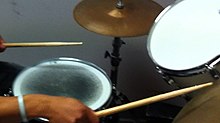
Drum muffles can reduce the ring, overtone frequencies, or volume on a snare, bass, or tom. Controlling the ring is useful in studio or live settings when unwanted frequencies can clash with other instruments in the mix. There are internal and external muffling devices which rest on the inside or outside of the drumhead, respectively. Common types of mufflers include muffling rings, gels and tape, and placing one's wallet near the edge of the head.
Snare Drum and Tom-Tom Typical ways to muffle a snare or tom is to place an object on the outer edge of the drumhead. A piece of cloth, a wallet, gel, or fitted rings made of mylar are common objects. Also used are external clip-on muffles that work using the same principle. Internal mufflers that lie on the inside of the drumhead are often built into a drum, but are generally considered less effective than external muffles.
Bass Drum Muffling the bass can be achieved with the same muffling techniques as the snare, but bass drums in a drum kit are more commonly muffled with pillows between the heads. Cutting a small hole in the resonant head can also produce a more muffled tone.
Silencers/Mutes Another type of drum muffler is a piece of rubber that fits over the entire drumhead or cymbal. It interrupts contact between the stick and the head which dampens the sound even more. They are typically used in practice settings.
Exemplary list of companies with muffle products:
- Evans
- Remo
- Pearl Drums
- Tama Drums
- Vic Firth
- Aquarian
- HQ Percussion
Historical Uses Muffled drums are often associated with funeral ceremonies as well, such as the funerals of John F. Kennedy and Queen Victoria. The use of muffled drums has been written about by such poets as Henry Wadsworth Longfellow, John Mayne, and Theodore O'Hara. Drums have also been used for therapy and learning purposes, such as when an experienced player will sit with a number of students and by the end of the session have all of them relaxed and playing complex rhythms.
Cases

Three types of protective covers are common for kit drums:
- Drum bags are made from robust cloth such as cordura or from cloth-backed vinyl. They give minimal protection, but are adequate for drums transported rarely and in private cars for example, and may be the only option for working drummers starting out, particularly when air travel is involved.
- Hard cases are of similar construction to suitcases, commonly of fibre composite.
- Flight cases or road cases are standard for touring drummers.
As with all musical instruments, the ultimate protection is afforded by a combination of a hard case or road case, padded on the inside, inside a soft padded bag.
Microphones

In "miking" a drum kit, dynamic microphones, which can handle high sound pressure levels are usually used to close-mic drums while condenser microphones are used for overheads and room mics.
Close miking of drums may be done using stands or by mounting the microphones on the rims of the drums, or even using microphones built in to the drum itself, which eliminates the need for stands for these microphones, reducing both clutter and set-up time. In some styles of music, drummers use electronic effects on drums, such as individual noise gates that mute the attached microphone when the signal is below a threshold volume. This allows the sound engineer to use a higher overall volume for the drum kit by reducing the number of "active" mics which could feed back at any one time.
Drum screens
Main article: drum screen
In some styles or settings, such as country music clubs or churches, the drummer may use a perspex or plexiglass screen to dampen the onstage volume of the drums.
A screen that surrounds the drummer is known as a drum booth.
Carpets
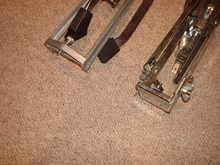
Drummers who play in different venues generally carry carpeting or mats. The primary purpose of this is to prevent the bass drum and hi-hat stand from slipping on a wooden floor or similar slippery surface.
The carpet also reduces short reverberation (which is generally but not always an advantage), and helps to prevent damage to the flooring or floor coverings.
Bass drums and hi-hat stands commonly have retractable spikes to help them to grip on surfaces such as carpet.
Practice equipment

Drummers often use a variety of accessories when they are practicing. Metronomes and beat counters are used to develop a steady rhythm. Drum muffling pads may be used to lessen the volume of drums during practicing.
A practice pad, either held on the lap or mounted on a stand, is used for silent practice with drumsticks. A set of practice pads mounted to simulate an entire drum kit is known as a practice kit; These have largely been superseded by electronic drums and kits with non-sounding mesh heads.
Tuning equipment
Main article: drum key
An essential need of every drummer is a drum key, which is used for tuning of drums and handling with drum hardware. Besides a basic type of drum key exist various tuning wrenches and tools. Basic drum keys are divided in three types which allows tuning of three basic types of tuning screws on drum: square (most used), slotted and hexagonal.
Playing
Grooves
Main article: drum beat

Kit drumming, whether playing accompaniment of voices and other instruments or solo, consists of two elements:
- A groove which sets the feel and provides a framework.
- Drum fills and other ornaments and variations which provide variety and substance.
Fills
Main article: drum fillA fill is a departure from the repetitive rhythm. Fills vary from a simple, single stroke on a tom, to sequences several bars long that are short drum solos in themselves.
As well as simply adding interest and variation to the music, fills serve an important function in preparing and supporting significant events in the music. A vocal cue is a short drum fill that introduces a vocal entry. A fill ending on a cymbal crash on beat one is often used to lead in to a chorus or verse.
Grips
Main article: grip (percussion)Most drummers hold the drumsticks in one of two types of grip:
- The traditional grip, originally developed for playing the military side drum, most commonly with an overhand grip for the right hand and an underhand grip for the left.
- The matched grip, in which the sticks are held in similar (but mirror image) fashion.
Within these two types, there is still considerable variation, and even disagreements as to exactly how the stick is held in a particular method. For example, Jim Chapin, an early and influential exponent of the Moeller method, asserts that the technique does not rely on rebound, while Dave Weckl asserts that it does rely on rebound.
Notation
Main article: percussion notation
Drum kit music is most commonly written on a standard five-line staff. These days a special percussion clef is used, while previously the bass clef was used. However even if bass or no clef is used, each line and space is assigned an instrument of the kit rather than to a note.
Audio samples
| Audio samples | ||
|---|---|---|
| Component | Content | Audio (Vorbis: click the arrow to play) |
| Snare | Unmuffled snare drum | |
| Muffled snare drum | ||
| Rim click on a snare | ||
| Bass drum | Muffled bass drum | |
| Toms | 8-inch (20 cm) rack tom | |
| 12-inch (30 cm) rack tom | ||
| Floor tom | ||
| Hi-hat | Closed hi-hat | |
| Open hi-hat | ||
| Hi-hat being opened and closed by its foot pedal (chick) | ||
| Crash | Crash cymbal | |
| Ride | Hit on the bow | |
| Hit on the bell of the cymbal | ||
| Hit on the edge | ||
| Beat | A typical rock beat on hi-hat | |
| Typical rock beat on ride cymbal | ||
| Video sample | ||
| Multiple components | Video illustrating basic drum kit actions | |
| See the Drums category at Wikimedia Commons for more | ||
See also
People:
Styles and techniques:
Other:
References
- Peckman gavin and adam (2007). Picture Yourself Drumming, p.30. ISBN 1-59863-330-9.
- http://www.music.vt.edu/musicdictionary/textd/drumkit.html retrieved 29 January 2012
- Remnant, M. (1989). Musical instruments. (pp. 159-174). London: B.T. Batsford Ltd.
- http://www.trinitycollege.co.uk/site/?id=1794 retrieved 20 March 2012
- Porter/Hullman/Hazel (1993). Jazz - From its Origins to the Present, p.18. ISBN 0-13-512195-7.
- ^ Porter/Hullman/Hazel (1993). Jazz - From its Origins to the Present, p.44. ISBN 0-13-512195-7.
- http://meinlpercussion.com/no_cache/percussion/meinl-percussion/timbales/action/show/Product/1323/#item1323 retrieved 28 February 2012: a pair of 8” diameter timbale shells with a depth of 9” and 11” respectively... 8" x 9", 8" x 11"
- Remnant, M. (1989). Musical instruments. (pp. 159-174). London: B.T. Batsford Ltd
- "Warren 'Baby' Dodds". The Percussive Arts Society. Retrieved 21 November 2011.
Dodds' way of playing press rolls ultimately evolved into the standard jazz ride-cymbal pattern. Whereas many drummers would play very short press rolls on the backbeats, Dodds would start his rolls on the backbeats but extend each one to the following beat, providing a smoother time flow.
- ^ Peckman (2007), p.31.
- Steve Weiss Music http://www.steveweissmusic.com/category/drum-sets 5/10/2012
- - drummufflers.com
- - Musician's Friend Tech Tip: Muffling Your Drums
- - Funeral of Queen Victoria
- - Funeral of John F. Kennedy
- - A Psalm of Life
- - The Muffled Drum
- - The Bivouac of the Dead
- Ryan , A. (n.d.). Learning to play the drum: an experiential. 43(4), 435-444.
- Drum Lessons - Drumbook.org
- http://www.youtube.com/watch?v=GZG311pfsGE retrieved 9/2/2012
- http://www.youtube.com/watch?v=QFZfOLbnBwI retrieved 9/2/2012
DrumsCrowd. Blog with interactive lessons drum beats==External links==
| Percussion instruments | |||||
|---|---|---|---|---|---|
| List of percussion instruments List of percussion instruments by type | |||||
| Pitched percussion |
| ||||
| Unpitched percussion | |||||
| Electronic percussion | |||||
| Percussion groupings | |||||
| Other | |||||
Template:Link GA Template:Link FA
Categories: